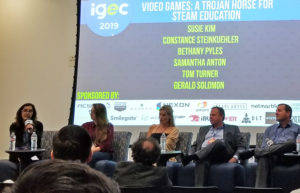Incorporating gaming into the classroom not only helps engage more young people, it can also promote a school’s mission of preparing more students for college and careers, according to a group of educators and experts who gathered at a UC Irvine conference Tuesday.
The 2019 Inven Global Esports Conference brought together hundreds of gamers, game developers, school leaders and others to UCI to discuss how the growing gaming phenomenon is changing industry, education, social engagement and other aspects of society. The conference included a panel on how esports can help students develop skills such as discipline, teamwork, critical thinking and focus.
 Last year, the Samueli Foundation launched in Orange County the North America Scholastic Esports Federation with the support of the Orange County Department of Education and other partners who were looking to connect young people’s interest in gaming to real-world learning. That league has since expanded into a national federation.
Last year, the Samueli Foundation launched in Orange County the North America Scholastic Esports Federation with the support of the Orange County Department of Education and other partners who were looking to connect young people’s interest in gaming to real-world learning. That league has since expanded into a national federation.
“Esports allows a student to engage in something that encourages them to collaborate and work together, and then finding that real-world connection that will bring all these things together,” panelist Tom Turner, OCDE’s executive director of Educational Services, said.
OCDE has worked to create an esports curriculum that incorporates the state’s Next Generation Science Standards, English and social-emotional learning. This coursework, which meets standards for admission into California’s public universities, can help supplement lessons in traditional high school English classes. Turner said he’s now working with educators to introduce an esports curriculum to middle schools.
Panelist Gerald Solomon, executive director for the Samueli Foundation, provided an example of how some schools have already adopted the curriculum. He pointed to a high school where students in an English course had to identify with a character in the game Overwatch, then write through blogs and essays about the strengths and weaknesses of the character and how they related to the students’ own experiences. Classmates then assigned one another different characters from the game to analyze how each character’s unique traits corresponded with those of the students.
“That’s a multi-sectional learning experience that required a student to think critically, write, then express herself verbally in front of her classmates,” he said. “These students are playing these games anyway. At least now we can bring them into a safe learning environment.”
